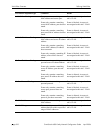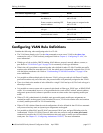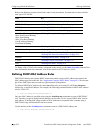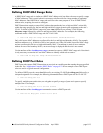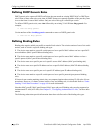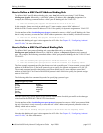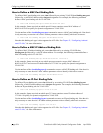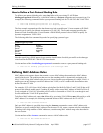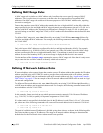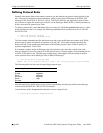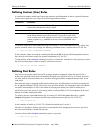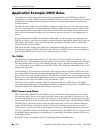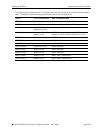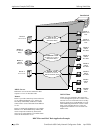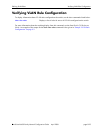
Configuring VLAN Rule Definitions Defining VLAN Rules
page 8-18 OmniSwitch 6600 Family Network Configuration Guide April 2006
Defining MAC Range Rules
A MAC range rule is similar to a MAC address rule, but allows the user to specify a range of MAC
addresses. This is useful when it is necessary to define rules for a large number of sequential MAC
addresses. One MAC range rule could serve the same purpose as 10 or 20 MAC address rules, requiring
less work to configure.
Frames that contain a source MAC address that matches the low or high end MAC or that falls within the
range specified by the low and high end MAC trigger dynamic port assignment to the rule’s VLAN. As is
the case with MAC address rules, dynamic port assignment is limited to a single VLAN. A mobile port
can only belong to one MAC range rule VLAN, even if it sends traffic that matches rules defined for other
VLANs.
To define a MAC range rule, enter vlan followed by an existing VLAN ID then mac range followed by
valid low and high end MAC addresses. For example, the following command creates a MAC range rule
for VLAN 1000:
-> vlan 1000 mac range 00:00:da:00:00:01 00:00:da:00:00:09
Only valid source MAC addresses are allowed for the low and high end boundary MACs. For example,
multicast addresses (e.g., 01:00:00:c5:09:1a) are ignored even if they fall within a specified MAC range
and are not allowed as the low or high end boundary MAC. If an attempt is made to use a multicast
address for one of the boundary MACs, an error message is displayed and the rule is not created.
Use the no form of the vlan mac range command to remove a MAC range rule. Note that it is only neces-
sary to enter the low end MAC address to identify which rule to remove.
-> vlan 1000 no mac range 00:00:da:00:00:01
Defining IP Network Address Rules
IP network address rules capture frames that contain a source IP subnet address that matches the IP subnet
address specified in the rule. If DHCP is used to provide client workstations with an IP address, consider
using one of the DHCP rules in combination with an IP network address rule. See “Application Example:
DHCP Rules” on page 8-22 for an example of how IP network address and DHCP rules are used in a typi-
cal network configuration.
To define an IP network address rule, enter vlan followed by an existing VLAN ID then ip followed by a
valid IP network address and an optional subnet mask. For example, the following command creates an IP
network address rule for VLAN 1200:
-> vlan 1200 ip 31.0.0.0 255.0.0.0
In this example, frames received on any mobile port must contain a network 31.0.0.0 source IP address
(e.g., 31.0.0.10, 31.0.0.4) to qualify for dynamic assignment to VLAN 1200.
If a subnet mask is not specified, the default class for the IP address is used (Class A, B, or C). For exam-
ple, either one of the following commands will create an IP network address rule for network 134.10.0.0:
-> vlan 1200 ip 134.10.0.0 255.255.0.0
-> vlan 1200 ip 134.10.0.0
The pool of available internet IP addresses is divided up into three classes, as shown in the following table.
Each class includes a range of IP addresses. The range an IP network address belongs to determines the
default class for the IP network when a subnet mask is not specified.



